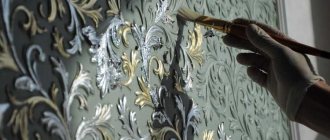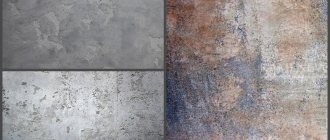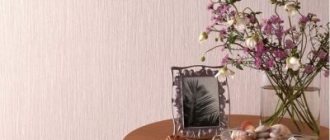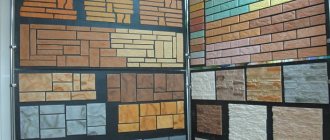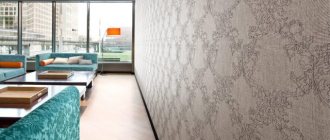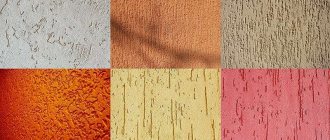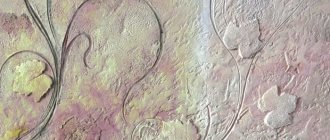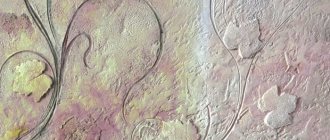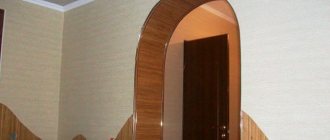Material selection
Recently very popular finishing styles tend to move away from a variety of colors and replace them with large spaces and minimal finishing. But few people can afford to buy a truly abandoned workshop and convert it into housing.
As a rule, in ordinary residential premises the illusion of abandoned production is created. For this, various finishing materials are used. On the Russian market, decorative plaster for concrete of various states is represented by several brands.
Plaster with imitation of various effects will require more skill and time to apply
When choosing packaging, pay attention to the following criteria:
- price,
- bag weight,
- material consumption per 1 m2.
Among other things, there are different effects among concrete finishes. Plaster can imitate wet facade concrete, metal, old and rusty, or fresh and untreated. Depending on the effect created, the complexity of applying decorative plaster also varies.
The average consumption for finishing with concrete plaster is 1.5 – 2 kg/sq.m. Having determined for yourself what type of wall you want to get in the end, you can easily choose the source material.
Basic principles of creating a loft-style room
This type of room design is often used for restaurants, workshops and other business options. But recently it has often been used for apartment interiors; softer types of loft are used. The basis for a design technique is the use of certain materials, or their imitation, so below we will discuss possible options.
The basis for a design technique is the use of certain materials or their imitation.
Materials used in loft interior
To obtain the desired background for the interior, you can use a small amount of materials. It is through their use that this effect is largely created. The following types of bases for finishing are distinguished:
- Using plaster, it is better to choose cold tones, as well as gray types of coatings, the texture is suitable with roughness;
It is better to choose cool tones, as well as gray types of coatings, the texture matches with roughness. - Concrete bases, different shades are used here, transitions from light to dark, concrete will not attract the eye, leaving the opportunity to focus on the furniture in the room;
Concrete will not attract attention, leaving the opportunity to focus attention on the furniture in the room. - A brick wall, on the contrary, attracts the eye, for this reason one wall is made of it, others can be made of concrete or plaster.
For residential premises, you can replace brick with imitating materials, for example, decorative stone.
Brick wall for this reason they make one wall out of it.
- Wood is often used for flooring. But a wall made of loft boards can be used in a certain area; this is how the wall behind the bed is highlighted; wooden finishes are well suited for a bedroom or living room;
Wooden finishes are well suited for a bedroom or living room. - Metal elements are usually not used for large parts. But they serve as an accent for individual items;
Metal elements serve as accents for individual items. - Glass partitions help solve the problem of the lack of walls in the room; visually it will seem that the room is unified.
Glass partitions help solve the problem of lack of walls in the room.
Advice from the experts
Finishing concrete walls and partitions using Loft Style decorative plaster requires taking into account the characteristics of the material. You can create the effect of a natural texture using a dishwashing sponge, which is used to scrape out areas and trowels for smoothing.
To decorate a concrete wall, it is better to use dark gray tones. The play of light and shadow can be ensured by painting in different shades. To get the right color, it is better to use paint tinting services in specialized stores.
When creating the effect of a concrete surface, you do not need to achieve mirror smoothness. Chips and microcracks will add naturalness to the design. It is better to entrust the application of the mixture to large areas to specialists. If you are processing it yourself, you will need an assistant to complete the work.
What does it look like
A “loft” is characterized not only by concrete walls, but also by brick and metal surfaces. If you do not have a panel apartment, then the concrete surface can be imitated using decorative plaster. The texture is rough, the color of gray cement, but lighter colors can be made. This decor creates the effect of a working atmosphere in subdued cold colors.
Look at the photo to see what concrete plaster looks like in the interior:
Bedroom
Bathroom
Living room
Kitchen
To imitate a wall made of slabs, concrete rectangles are drawn on fresh plaster, and decorative elements are added in the form of rivets, mounting elements, etc. By the way, the texture of gray cement plaster is used not only in “loft”, but also in “high-tech”.
Brick plaster, imitation of Loft style masonry
Another way to imitate brick is plaster. This method also has its advantages in decorating a wall, these are:
- low financial costs;
- environmental friendliness;
- thin layer;
- the opportunity to make plaster with your own hands.
In order to make brick plaster, it is not necessary to be a qualified specialist.
For plastering work the following tools and materials are needed:
- Adhesive tape 10 mm wide, a lot, a lot.
- Water level.
- Roulette.
- Plaster mortar.
- Two or three colors to give color to future bricks.
- The bucket is plastic.
- Mixer with speed control.
- Painting cord with colored powder.
For the plaster mortar, you can use façade plaster of the “Bark Beetle” type.
The main stage and especially labor-intensive part of the work is breaking the wall into individual bricks. First, on the opposite edges of the wall, we make a vertical breakdown every 75 mm. After this, the two of us use a paint cord to mark off the horizontal lines. We stick tape along these lines - these will be horizontal seams between the bricks. After the horizontal ones, glue the vertical lines for the vertical seams.
Imitation of a brick wall using plaster
At this stage of work, the main thing is not to make oblique seam lines. After applying a mesh of tape that imitates seams, feel free to tackle the plaster. To give the bricks a relief, the mortar is applied by hand and smoothed over the wall. To give the texture a deep relief, use hard brushes, sponges, etc. After waiting a while for the solution to begin to set, but not harden, remove the seams glued with adhesive tape. To do this, you just need to pull the tape, starting from the edge, and you will get a brick wall. The tape will remove excess mortar and expose the wall, simulating seams between bricks. Next, you need to cut the seams with colored plaster and paint the bricks in the desired color.
In addition to tape, seams can be cut directly onto the plastered wall.
There are several ways to cut bricks on a plastered wall. To do this, you need to make a special tool from an elastic tape, as in the photo above.
After the solution has dried a little, use a level and a jointing tool to cut horizontal and vertical seams.
Advice! To make the masonry more realistic, make the seams a little curved, within reasonable limits, of course.
How to make decorative brick, watch this video:
About the material
For interior wall decoration, ready-made mixtures are used to create wear-resistant surfaces. The materials differ in their base, color scheme, and method of application.
The composition of the plaster to create the effect of a concrete surface includes the following ingredients:
- cement;
- water;
- quartz sand;
- mineral pigments;
- additives.
The mixtures perfectly reproduce the effect of natural concrete and are easily applied to the surface. Lime-based plaster ensures environmental safety. Innovative additives that are part of the material give the surface the effect of metal and silk.
Compositions with decorative properties are intended for finishing. With the help of dyes, it is possible to move away from gray tones and create a colorful interior.
Advantages
Decorative plaster allows you to create interiors with different effects. Often in rooms decorated in a loft style, there is interior concrete wall decoration, which looks stylish. The surface created by the decorative mixture is durable and easy to maintain. The operational parameters of the mixture allow it to be used for interior and exterior decoration. The material is durable, resistant to atmospheric factors, high humidity, and temperature changes.
The plaster retains its original color for a long time. The texture of concrete does not have a smooth texture or uniform color, so damage and scratches will be visually hidden on the wall.
Some decorative mixtures tend to change color and texture depending on the intensity of lighting. By installing different levels of light in a room, you can change the style from classic to hi-tech.
Attractiveness
Cold interiors in gray tones look appropriate in non-residential premises, large rooms, studio apartments with a layout with free zoning. The loft plaster used in the design attracts with its simplicity of style and texture.
The material is easy to apply, so finishing work can be done independently. The mixture is resistant to moisture, mold and fungi do not form on the treated surface. Loft style finishing emphasizes the design of the room.
Choice
When choosing packaging, you need to pay attention to its weight, cost, and consumption. Before purchasing a mixture, it is recommended to make a preliminary calculation of the need for materials based on consumption rates.
To apply a layer 1 cm thick per 1 m², you need 15 kg of cement-sand mortar and 10 kg of gypsum composition. Materials containing gypsum are not recommended for use in rooms with high humidity. Before finishing, you need to familiarize yourself with their properties in order to choose the optimal application option.
Liquid material is inconvenient to work with and cannot be diluted with water. The mixture with coarse fillers should be applied manually. Water-based concrete materials are non-toxic, but are less resistant to external influences.
When choosing a coating, design features are taken into account. Decorative plaster with a concrete effect is used to decorate walls, ceilings, and furniture elements. The features of the loft style are emphasized by the use of material to create a Tuscan texture. With its help, an optical effect of a relief surface in the form of brush strokes is obtained.
Shine and color transitions are achieved with a mixture that contains metal granules. This coating emphasizes the individuality of the design solution. The cypolin effect enhances the expressiveness of the texture of the material, conveys the characteristics of the metal, right down to the reflection.
